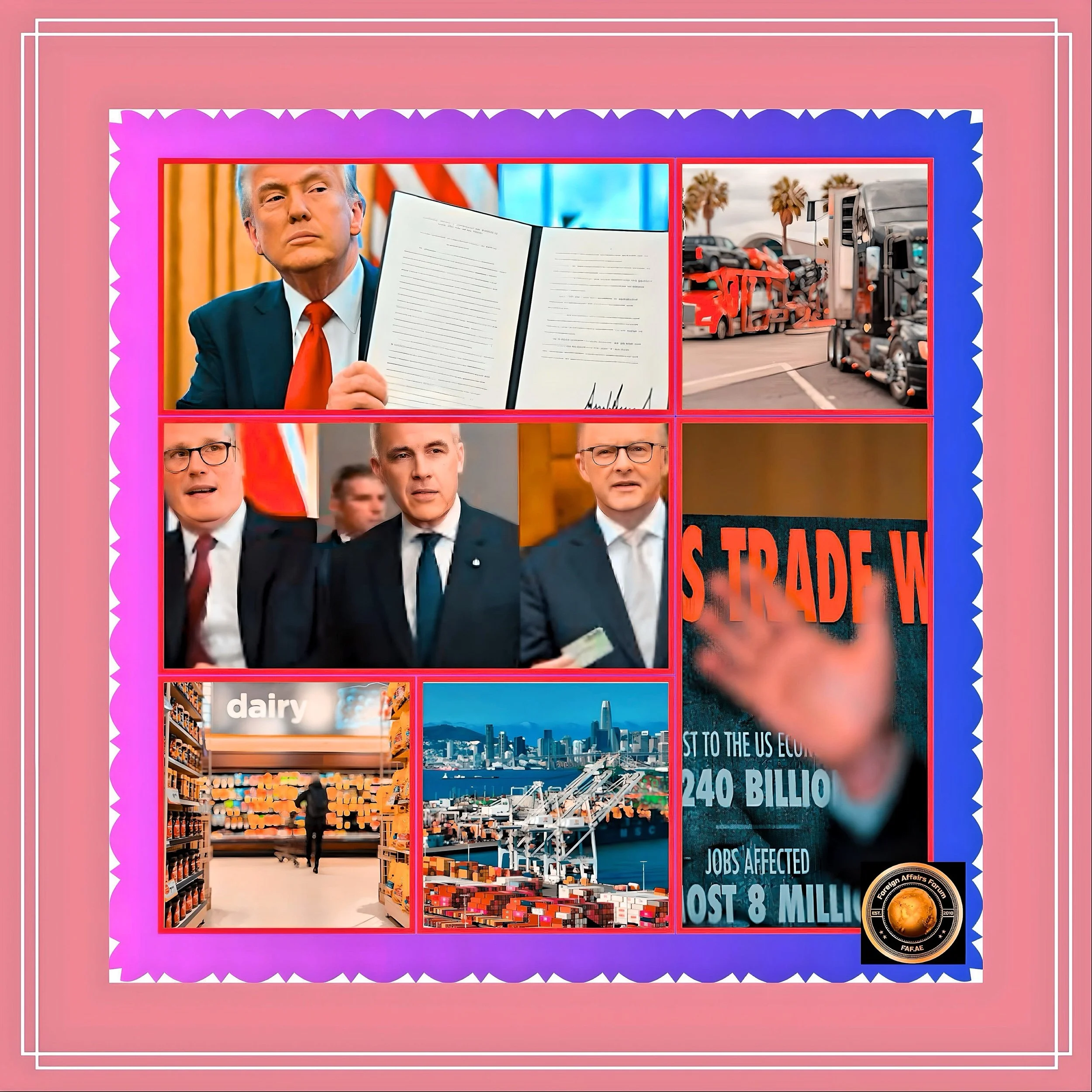US Strategic Posturing in the Middle East and Eastern Europe: Objectives, Risks, and Global Implications
Executive Summary
Under President Donald Trump, the United States has adopted an aggressive foreign policy stance characterized by military posturing, economic coercion, and ultimatums to reshape geopolitical dynamics in the Middle East and Eastern Europe.
Central to this strategy is the dual-track approach of threatening catastrophic military action while pushing for renegotiated agreements on nuclear proliferation (Iran) and regional conflicts (Ukraine).
The deployment of B-2 Spirit stealth bombers to Diego Garcia, threats of secondary tariffs on Russian oil, and sustained airstrikes against Houthi forces in Yemen reflect a calculated effort to project strength. However, analysts warn of escalating risks of miscalculation.
While the administration claims its actions are designed to force adversaries to negotiate, critics argue that the lack of coherent diplomacy and reliance on maximalist demands could inadvertently trigger broader conflicts.
US-Iran Nuclear Negotiations and Escalating Threats
Iran’s Red Line on Nuclear Weapons
Iran has explicitly warned that it will pursue nuclear weapons if the US launches military strikes against its territory, according to Ali Larijani, a senior adviser to Supreme Leader Ayatollah Ali Khamenei.
This declaration follows Trump’s threats of “devastating bombings” unless Tehran agrees to a new nuclear deal within a two-month deadline.
The ultimatum, delivered via Omani mediators, demands curbs on Iran’s uranium enrichment and ballistic missile programs.
However, Iran has rejected direct talks, insisting on indirect negotiations through intermediaries—a stance rooted in distrust stemming from the US withdrawal from the 2015 Joint Comprehensive Plan of Action (JCPOA).
Military Preparations and Brinkmanship
The US has deployed at least seven B-2 Spirit stealth bombers to Diego Garcia, a remote Indian Ocean base beyond the range of Iranian missiles.
These aircraft are capable of delivering 30,000-pound Massive Ordnance Penetrator (MOP) bombs designed to destroy fortified nuclear facilities like Fordow and Natanz. Satellite imagery confirms their arrival, signaling readiness for potential strikes.
Concurrently, joint US-Israeli air exercises have simulated attacks on Iranian targets, leveraging B-52 bombers and F-35 fighters to demonstrate interoperability.
Iranian officials have countered by threatening retaliation against any base used for US operations, including facilities in Qatar and the UAE.
Diplomatic Stalemate and Regional Proxy Conflicts
The nuclear standoff is intertwined with regional proxy wars. US airstrikes against Houthi rebels in Yemen—a group armed and trained by Iran—aim to degrade Tehran’s influence while pressuring it to concede in negotiations.
However, the Houthis have intensified attacks on Red Sea shipping lanes, framing their actions as solidarity with Gaza amid Israel’s military campaign against Hamas.
Trump’s linkage of Yemeni hostilities to Iranian intransigence underscores the administration’s view of the Houthis as a lever to compel Tehran’s compliance.
Strategic Deployment of B-2 Bombers to Diego Garcia
Diego Garcia’s Role in US Power Projection
The Chagos Archipelago base, leased from the UK, provides a secure launchpad for long-range bombers due to its isolation from Iranian retaliatory strikes.
With a runway capable of handling B-2s and proximity to the Persian Gulf (3,300 miles), Diego Garcia allows the US to sustain operations without relying on volatile regional allies.
This positioning mitigates risks posed by Iran’s Bavar-373 and Russian S-400 air defense systems, which could target closer bases like Al Udeid in Qatar.
Operational Capabilities and Mission Parameters
The B-2’s stealth technology evades radar detection, while in-flight refueling extends its 6,000-mile unrefueled range.
Missions would likely involve ascending to high altitudes to deploy MOP bombs, using GPS-guided fins to penetrate up to 200 feet of reinforced concrete.
However, analysts note that even successful strikes would only delay—not eliminate—Iran’s nuclear program, as dispersed and buried facilities complicate targeting.
Signaling Intent and Deterrence
The bomber deployment serves multiple objectives
Coercive Diplomacy
Demonstrating resolve to Iran ahead of negotiations.
Deterrence
Discouraging Houthi attacks on shipping by showcasing capacity to strike Iranian allies.
Regional Assurance
Reassuring Gulf partners of US commitment amid doubts over Trump’s “America First” policies.
Critics, however, argue that the move risks normalizing brinkmanship. Former officials like Rita Pars of the Quincy Institute warn that “escalating rhetoric may entrap both sides in a conflict neither wants.”
US-Russia Relations: Sanctions, Tariffs, and Ukraine Ceasefire Efforts
Trump’s Tariff Threat and Kremlin Response
Trump has threatened 25–50% secondary tariffs on countries purchasing Russian oil unless Moscow facilitates a Ukraine ceasefire.
Though enforcement challenges persist, this unconventional tactic aims to economically isolate Russia by penalizing major buyers like China and India.
The Kremlin has dismissed the threats as “counterproductive” but confirmed backchannel talks to restore bilateral ties and explore peace frameworks.
Ukraine’s Precarious Position
Despite Trump’s claims of progress, ceasefire negotiations remain stalled. Russia insists Ukraine’s government lacks legitimacy due to postponed elections, while Kyiv demands complete territorial restoration.
Trump’s disparagement of President Zelensky as a “dictator” and accusations of reneging on a rare earth minerals deal have further strained relations.
Meanwhile, US intelligence reports indicate Russia’s incremental advances in Donbas, exploiting Ukraine’s ammunition shortages and Western aid delays.
Strategic Ambiguity and European Concerns
European allies fear Trump’s transactional approach undermines NATO cohesion. His refusal to explicitly blame Russia for the war and sporadic praise for Putin contrast with demands for increased defense spending from EU members.
The proposed tariffs, while unprecedented, align with Trump’s broader use of economic weapons—a pattern seen in secondary sanctions against Venezuela and Iran.
Yemen’s Houthi Conflict and Regional Proxy Dynamics
US Objectives in Yemen
The Trump administration frames its bombing campaign against the Houthis as necessary to protect Red Sea shipping and counter Iranian influence.
Since March 2025, over 120 airstrikes have targeted missile depots and drone launch sites, with Defense Secretary Pete Hegseth vowing to continue until “freedom of navigation is restored.”
However, the Houthis remain defiant, leveraging Iranian-supplied missiles to harass commercial vessels and Israeli-linked targets.
Humanitarian and Strategic Costs
Civilian casualties from US strikes—including a March 15 attack that killed 12 non-combatants—have drawn condemnation from human rights groups. Moreover, the focus on Yemen distracts from broader regional priorities, such as containing Iran’s nuclear ambitions and stabilizing Gaza.
Critics argue that the campaign risks entrenching the Houthis while failing to address root causes like Saudi Arabia’s blockade and Yemen’s humanitarian crisis.
Trump’s Diplomatic Calculus: Coercion, Tariffs, and Maximum Pressure
The “Maximum Pressure” Revival
Trump has reinstated sanctions targeting Iran’s oil exports and financial sectors, seeking to reduce revenues funding regional proxies.
However, experts note that China and India continue importing Iranian crude through covert networks, limiting the policy’s efficacy.
Similarly, threats to “zero out” Russian oil sales face logistical hurdles, given Moscow’s ability to reroute exports via shadow fleets.
Leveraging Military Threats for Diplomatic Gains
The administration views shows of force—such as B-2 deployments and joint exercises—as tools to extract concessions.
Michael Horowitz of Le Beck International notes that strikes on Houthi targets are partly intended to “signal seriousness” to Iran ahead of nuclear talks.
Yet, Tehran has dismissed such tactics, with Foreign Minister Abbas Araghchi stating, “We will not negotiate under threat.”
Political Considerations and Domestic Audiences
Trump’s combative rhetoric appeals to his base ahead of the 2026 midterms, framing him as a decisive leader confronting “terrorists” and “dictators.”
However, his inconsistent messaging—alternately praising and condemning Putin—has confused allies and adversaries alike.
The White House’s dismissal of a leaked Atlantic report on Yemen strike plans as a “hoax” further illustrates the administration’s sensitivity to perceptions of disarray.
Assessing the Risk of War: Strategic Posturing vs. Diplomatic Bluff
Pathways to De-Escalation
Both US and Iranian officials have privately desired to avoid direct conflict. Backchannel communications via Oman and Switzerland suggest ongoing efforts to restart nuclear talks, albeit under stringent US conditions.
Similarly, Russia’s engagement with Trump’s ceasefire proposals indicates a tentative openness to dialogue despite public posturing.
Triggers for Conflict
Miscalculation
A Houthi attack causing significant US casualties could prompt disproportionate retaliation against Iran.
Israeli Initiative
Israel might preemptively strike Iranian nuclear sites, dragging the US into war.
Breakdown in Negotiations
Military action becomes likely if Tehran crosses Trump’s two-month deadline without concessions.
Economic and Global Repercussions
A US-Iran war would disrupt 30% of global oil shipments through the Strait of Hormuz, spiking energy prices and destabilizing economies reliant on Gulf hydrocarbons.
Secondary tariffs on Russian oil could similarly roil markets, alienating China and India while straining transatlantic relations.
Conclusion
The Perils of Coercive Diplomacy
The Trump administration’s reliance on military threats and economic coercion carries high risks for marginal gains.
While deploying B-2 bombers and secondary tariffs may temporarily pressure adversaries, they exacerbate regional instability and erode US credibility.
Iran’s nuclear latency, Russia’s entrenched position in Ukraine, and the Houthis’ resilience demonstrate the limits of unilateral force.
A sustainable strategy requires rebuilding multilateral partnerships, offering phased sanctions relief, and addressing root grievances—whether Iran’s security concerns or Russia’s territorial ambitions.
Absent such shifts, the current trajectory risks entangling the US in preventable conflicts with global repercussions.






